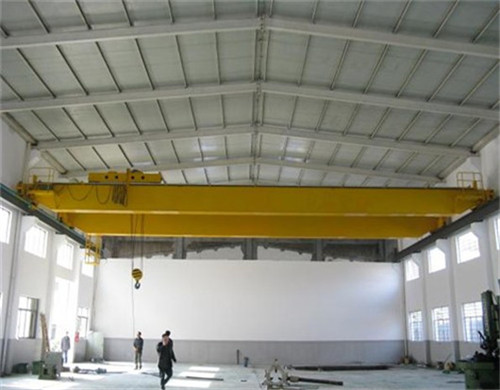What is an Overhead Crane?
An overhead crane allows heavy materials to be lifted and moved from one location to another. When it comes to choosing the best crane for your business, there is no one crane that will fit every purpose. Each crane is specifically designed and engineered for a particular application to suit the material handling needs of a company. Custom overhead cranes can be built in different types of configurations and components can be engineered to improve its performance and capacity.

Advantages of Using an Overhead Crane
Some of the most common advantages and overhead crane include the following:
– Lifting and moving heavy materials around a facility more safely and efficiently than using a tow motor or manual labor.
– Feeding materials into a machine at a manufacturing facility.
– Flipping in and pulling out dies from a stamping machine in a manufacturing facility.
– Moving containers around a railyard or shipyard.
– Moving material parts down an assembly line in a controlled and precise manner.
In addition to simplifying processes in the applications mentioned above, there are two main reasons why companies install an overhead crane (or a series of overhead cranes) in their facilities:
1. Efficiency
It is a significantly more efficient way to lift and move materials than using tow motors or a group of manual workers and can work two to three times faster. For example, a manufacturing warehouse or mill can streamline their procedures by introducing an overhead crane to automatically lift, maneuver, and unload materials.
2. Safety
Safety is one of the major advantages of installing an overhead crane in an assembly, warehousing or manufacturing facility. Overhead cranes are designed to lift and safely move materials in extreme environments and are capable of handling extremely heavy loads as well as dangerous materials such as chemicals, hot metals, and other hazardous materials. A jib crane or workstation can be installed to move heavy objects in a controlled manner that helps cut down the risk of injuries in the workplace such as muscle strain and repetitive motion injuries.
Other benefits of installing an overhead crane system include:
Other benefits to using an overhead crane system include:
– Reduction in work-related accidents.
– Reduction in damage to materials, products, or property.
– Lowered costs.
– Provides a green solution that greatly reduces environmental impact.
Different Types of Overhead Cranes
Selecting the right type of overhead crane for your purposes is essential to streamlining the production processes in your facility. As there is no “one type suits all” solution, the following should be taken into consideration when identifying the right type for your specific lifting requirements:
• Weight and type of material or loads to be moved
• The motion of the crane structure
• Required capacity
• Location – indoors or outdoors
• Span or length of the crane
• How often the crane will be used
Bridge Cranes
Bridge cranes come in different configurations depending on the structure of the building and the requirements needed to make a lift and includes single or double girder designs and a trolley or hoist designed to be top- running or underhung.
Gantry Cranes
Similar to a bridge crane that uses suspended runways, but a gantry crane utilizes legs to support the bridge, hoist, and trolley that travel on fixed rails laid on top or embedded into the floor. They are typically used for outdoor applications or below an existing bridge crane system. They are most commonly used in railyards, shipyards, bridge construction, or steel mills where overhead space is an issue.
Monorail Cranes
A monorail crane uses a trolley to carry a hoist along a single path and is most commonly found in assembly or production line facilities. The crane can be designed to run in a straight line or on a curved trace with branches, switches, and changes in elevation. They are designed for lifts that do not require a side-to-side trolley movement as provided by a gantry or overhead crane.
Jib Cranes
Jib cranes do not utilize a track or runway system and can be stand-alone or wall/column mounted. They provide a wide variety of options for heights, spans and weight capacities. They are economical, space-saving, and ideal for maneuvering assembly items in a small area.
Workstation Cranes
Designed for lifting and moving loads with limited effort it offers operators an ergonomic means to operate in a small workspace. They are typically utilized for lighter-duty operations and can lift materials from 150lbs to 2 tons. They are ideal for repetitive load lifting, ease of workflow, and increased worker productivity. Workstation cranes can be freestanding or ceiling hung with top or under running operations.
All in all, there are more information about 50 ton overhead cranes and more information about overhead cranes here: https://overheadcranesuppliers.com/50-ton-overhead-crane/